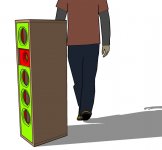Hello Joe, I've almost finished building the Elsinore. Let's say that now the baby has the bones, but he needs the skin(the paint),the heart( drivers) and the brain(crossover).
One question about the port: I took a 90mm inside diameter tube, when I saw that inserting the tube into the cabinet made it 87mm inside diameter( infact inserting the tube is a little hard, I could have made the hole radius little larger but I prefer this way because it's firmly embedded into the cabinet) so I thought that I could cut it to 80/81mm.
One question about the port: I took a 90mm inside diameter tube, when I saw that inserting the tube into the cabinet made it 87mm inside diameter( infact inserting the tube is a little hard, I could have made the hole radius little larger but I prefer this way because it's firmly embedded into the cabinet) so I thought that I could cut it to 80/81mm.
Is it 80mm the correct lenght for 87mm inside diameter? I seen you wrote outside, isn't inside?87mm outside = 80mm - OK
nitronori said:
Is it 80mm the correct lenght for 87mm inside diameter? I seen you wrote outside, isn't inside?
Actually, if you look closely there is a typo there, so here it is without typo:
Internal Diameter = Vent Length:
90mm = 88mm - OK
87mm = 80mm - OK
85mm = 75mm - OK
82.5 = 69mm - Borderline
80mm = 63mm - TOO SHORT
77.5mm = 57mm - TOO SHORT
75mm = 52mm - TOO SHORT
The 'ideal' that I am using is 90mm Outside, 87mm Inside and 80mm Length. Sounds like you are right on the money.
Joe R.
BL4S7ER said:IMAGES
Can I post some of these on the website. Not sure where I'd put it, but I like the translucent detail. Nicely done.
Cheers.
Joe
XO in the box?
What are the benefits of having an external crossover?
1. I imagine that it is nice to have it outside the box while tuning a design, but with Joe's hard work on perfecting the design I don't think I need that benefit.
2. Interaction between speaker coils, magnetics and inductors has been mentioned, but then with the Elsinore one could put the cross-over components in the bottom of the box.
3. The crossover components produce heat and add to the voice coil heat inside the box, but I usually play at low volume.
What do you say? Will it be a big sin to put the crossover inside the Elsinore box?
The benefit to me are;
1. Cleaner looks and better WAF
2. Fewer connectors to buy, construct and worry about.
Sorry if I missed the verdict in earlier posts.
Francois
P.S. I have the drivers and box material. Will start building shortly. Currently I'm buying the crossover components.
Francois
What are the benefits of having an external crossover?
1. I imagine that it is nice to have it outside the box while tuning a design, but with Joe's hard work on perfecting the design I don't think I need that benefit.
2. Interaction between speaker coils, magnetics and inductors has been mentioned, but then with the Elsinore one could put the cross-over components in the bottom of the box.
3. The crossover components produce heat and add to the voice coil heat inside the box, but I usually play at low volume.
What do you say? Will it be a big sin to put the crossover inside the Elsinore box?
The benefit to me are;
1. Cleaner looks and better WAF
2. Fewer connectors to buy, construct and worry about.
Sorry if I missed the verdict in earlier posts.
Francois
P.S. I have the drivers and box material. Will start building shortly. Currently I'm buying the crossover components.
Francois
With the xo in a box mounted on the back of speaker cabinet all the connection will be exactly the same as with xo inside
When people first began to have the xo outside the box it was because they thought that the acoustic pressure inside the box and vibrations could have an affect the sound through the xo components
I dont remember how many inducters are used, but its good to have them as far away from each other as possible
On the other hand, a person who I respect, once told me that it is good to have xo components, compensation curcuits especially, real close to each related driver
When people first began to have the xo outside the box it was because they thought that the acoustic pressure inside the box and vibrations could have an affect the sound through the xo components
I dont remember how many inducters are used, but its good to have them as far away from each other as possible
On the other hand, a person who I respect, once told me that it is good to have xo components, compensation curcuits especially, real close to each related driver
Thanks for your replies, Rob323 & tinitus. The phasing fix is one I will have to keep in mind.
I would like to be able to upgrade/update Xover components (and fix any assembly misadventures in phasing), so I'm probably going to stick with the external Xover.
Thanks and best,
Francois
I would like to be able to upgrade/update Xover components (and fix any assembly misadventures in phasing), so I'm probably going to stick with the external Xover.
Thanks and best,
Francois
Francois G said:I searched the thread for crossover frequencies but could not find it. (I'm sorry if has been discussed and I missed it)
Does someone know the crossover frequencies for both M/T and MTM/MM? Joe?
Thanks
Francois
The upper crossover is around 3KHz, but the lower one is more difficult to define as there is no high pass filter a la 2 1/2 Way systems. So it is the deviation in the response that matters, where below that frequency the lower two drivers fill in the diffraction loss. This is about 400 Hertz. Will that do?
Joe R.
Re: Resistor watts
I use Dale 5W and the Mills 5W should be just fine too. Each "leg" of the crossover is effectively 16 Ohm, so 5W would equal 10W if it was 8 Ohm and 20W if it was 4 Ohm - mind you this is just a rule of thumb, but gets the idea across.
Joe R.
Francois G said:I could not find information on the minimum watts for the cross-over resistors. I bought 5 watt Mills non-inductive resistors but I am wondering if I needed it higher watts.
Thanks.
I use Dale 5W and the Mills 5W should be just fine too. Each "leg" of the crossover is effectively 16 Ohm, so 5W would equal 10W if it was 8 Ohm and 20W if it was 4 Ohm - mind you this is just a rule of thumb, but gets the idea across.
Joe R.
rob323 said:There is no need to change the lower two drivers to a different type, and besides, a change in driver would also require a change in cabinet and tuning.
Would require a different design. Anybody putting their hands up?

Joe R.
beauistheman said:so you`ve tired [tried?] these? They deliver nice bass?
Rob, you answer that, so over to you.
[] added.
Joe R.
- Home
- Loudspeakers
- Multi-Way
- The "Elsinore Project" Thread

